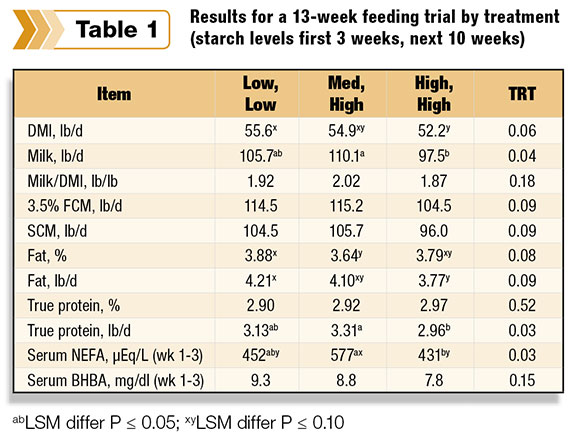During the past decade, the dairy industry has widely adopted higher-fiber, lower-energy pre-calving diets. With these diets, cows are fed closer to their energy requirements, and an improvement in postpartum metabolic health has been demonstrated in a number of research studies and in numerous field experiences.
However, what is the optimal starch level to feed the fresh group when low-starch diets are fed pre-freshening?
Starch can be a big driver of milk production and, hence, the interest in “cranking it up.” Here’s why. In the rumen, starch fermentation primarily generates propionate.
In the small intestine, starch is absorbed as glucose and converted to lactate for transport to the liver.
Either way, both are primarily converted to glucose in the liver. The glucose is used to make lactose in the udder, which drives milk production. If a shortage of glucose or its precursors occurs, however, the cow’s susceptibility to ketosis increases.
Gradually increasing grain as cows move between different transition groups has been stressed historically for three reasons.
1. The time required for rumen papillae development
2. The adaptation of rumen microbial populations
3. The hepatic oxidation theory
I’ll explain. Volatile fatty acids – primarily acetate, propionate and butyrate – are produced in the rumen when ruminal microbes ferment carbohydrates. The VFAs exit the rumen through absorption via the rumen papillae or pass out of the rumen.
Theoretically, if the grain content of the ration was gradually increased as cows moved between groups, there would be time for the rumen papillae to expand in size and absorptive capacity.
This would then reduce the risk of sub-acute rumen acidosis developing as cows are moved to diets with more rumen-fermentable carbohydrates.
The primary study indicated that it may be beneficial to rumen papillae to step up grain feeding in the transition period.
However, in this trial cows were switched from a straw-based diet that contained approximately 75 percent NDF diet and had very little rumen-fermentable carbohydrates to a much more digestible diet.
A more recent study, conducted with starch levels more similar to those typically seen in today’s pre-fresh diets, did not find a benefit to papillae development from feeding additional grain in the pre-fresh period.
Based on the individual cow, however, some time may be needed for the rumen microbial population to adapt to increased grain levels.
Additionally, other important changes are occurring in the gastrointestinal tract. Blood flow to the GI tract increases dramatically in the days following calving.
The more recent study found that pre-calving blood flow levels approximately doubled by 11 days in milk (DIM). Increased blood flow to the rumen may also help to reduce the risk of sub-acute rumen acidosis by removing volatile fatty acids from the rumen more quickly.
The hepatic oxidation theory (HOT) poses another concern with high rumen-fermentable starch levels in the fresh group. The ruminal fermentation of starch yields relatively more propionate while the ruminal fermentation of fiber yields more acetate.
The basis for HOT is that substrates, such as propionate, produced during the digestion of feedstuffs can affect feed intake.
In a fresh cow that has lost body condition and has elevated levels of fat in her liver, an increase in propionate levels could result in the oxidation or “burning” of some of this fat.
A signal would then be sent to the cow’s brain to end her meal, and an overall decrease in feed intake would occur.
If liver fatty acid levels were not elevated, or possibly if propionate rose slowly over time rather than spiking, a shortened meal time and the correlated reduction in intake may not have occurred.
Researchers at the Miner Institute fed a typical controlled-energy, straw-containing pre-fresh diet during the dry period.
At freshening, 72 cows were fed one of the following treatments: A low-starch diet (Low, 21.0 percent starch) for the first 91 days postpartum; a medium-starch diet (Med, 23.2 percent starch) for the first 21 days postpartum followed by a high-starch diet (High, 25.5 percent starch) until day 91; or a high-starch diet (High, 25.5 percent) for the first 91 days postpartum.

To reduce starch levels in the low and medium diets, corn meal was partially replaced with soy hulls and wheat midds.
The results for the 13-week trial are shown in Table 1 .
The results demonstrate that starch level can have a real influence on early lactation performance.
Cows fed the high-starch diet (25.5 percent) did not eat as much as those fed the low-starch diet (21.0 percent) and produced less milk than those fed the medium-starch (23.2 percent followed by 25.5 percent) step-up diet.
Cows fed the high-starch diet also produced significantly less protein than those fed via the step-up program and less fat than cows fed the low-starch diet.
The biological reasons for these differences are unclear. Possibly excessive propionate reduced intake in the high-starch diet as with HOT.ok
Sub-acute rumen acidosis may also have occurred due to problems with microbial adaptation, papillae development, ruminal blood flow rates or some other cause.
What’s the bottom line? More research needs to be done in this area. Until then, when feeding pre-fresh cows controlled-energy diets to optimize production, carefully select the starch levels in the fresh cow diets. PD
Stone is a veterinarian with a Ph.D. in dairy cattle nutrition with more than 20 years of experience in dairy management and nutritional consulting.
References omitted due to space but are available upon request. Click here to email an editor.

Bill Stone
Technical Service Director
Diamond V







